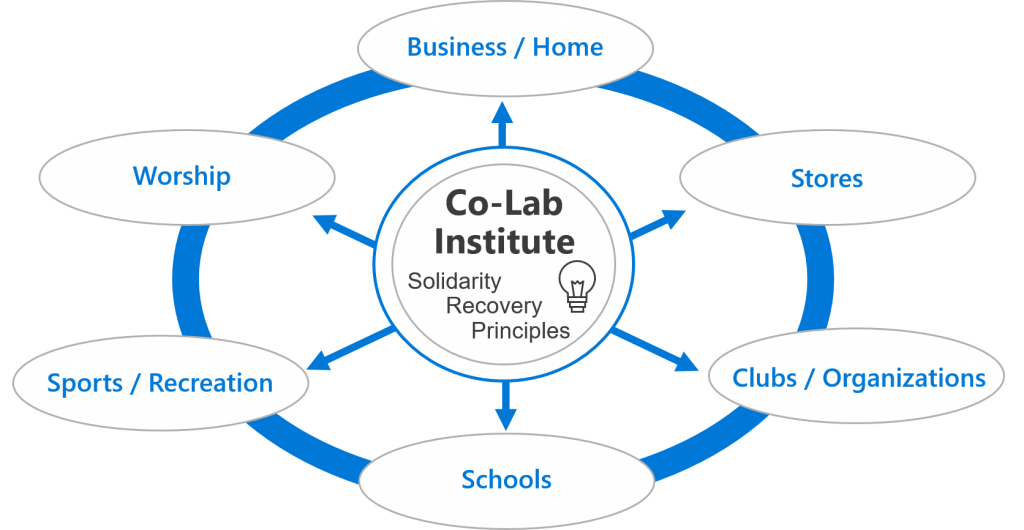
Opening Insights
Addiction: Nature Vs. Nurture
The recovery industry has attested for many years that addiction is a family disease. While evidence points to both biological and hereditary genetics, the fact is that the environmental effects of addiction are undeniable and evidence-based.
Informational Insights
…Human beings have a natural and innate need to bond, and when we’re happy and healthy, we’ll bond and connect with each other, but if you can’t do that, because you’re traumatized or isolated or beaten down by life, you will bond with something that will give you some sense of relief. Now, that might be gambling, that might be pornography, that might be cocaine, that might be cannabis, but you will bond and connect with something because that’s our nature. That’s what we want as human beings.
(Hari, 2015)
With the problem and cause of addiction clearly defined one must therefore ask: why are the old recovery models of individual treatment still taught, practiced and maintained? Is it that the recovery industry cannot find a solution or is it that they don’t want a solution?
“…We’ve traded floorspace for friends, we’ve traded stuff for connections, and the result is we are one of the loneliest societies there has ever been.… [We] talk all the time in addiction about individual recovery, and it’s right to talk about that, but we need to talk much more about social recovery. Something’s gone wrong with us, not just with individuals but as a group, and we’ve created a society where, for a lot of us, life looks a whole lot more like [an] isolated cage[]…”
(Hari, 2015)
Recovery as an individual exercise is predominantly followed by relapse. Recovery as a systemic environmental change prepares the addict to meet and overcome past influences and situations where resolution was before unattainable. True addiction recovery needs to address both the environmental and the biological causes of addictions.
To do this, we must take the sliver out the same way it came in. This does not mean we need to cure the alcoholic with alcohol or the crack addict with crack or the heroin addict with methadone – these programs have proven to be ineffective in long-term recovery. It means that we need to accept both the environmental and biological challenges addicts face and confront them head on.
Solutions Orientated Recovery
One may come into the world with an addictive gene but the environment is what triggers and conditions the addict to seek external solutions to “deal with life.” Maturity stops at the age when an addict picks up a chosen substance, chemical or behavioral process. Over time the behavior of seeking an outside means to manage emotional stimuli becomes an automatic reaction to managing, coping and dealing with life. Akin to learning how to ride a bike; at first we must choose to balance and decide when to put our feet down, but once learned we can do it without thinking.
Returning to the principle of taking the sliver out the same way it went in: We must identify the triggers and root causes of the automatic reactions, unlearn the associated beliefs then learn and relearn mature thinking processes to create new neural pathways in the brain. This can only be done through the repetition of new experiences that reinforce healthy and mature thinking and reasoning processes:
- Relating and collaborating with others
- Learning how to think, rather than what to think
- Dealing with life on life’s terms
Given these realities one need not argue the flaws of traditional treatment and recovery models, in which a high recidivism rate is unavoidable. How will a recovering addict ever hope to change if they go from treatment, right back to their homes and lives that drove them into rehab in the first place?
What must be done?
“The opposite of a problem would likely be the correct solution.”
Joey Lawsin
 The solution is to provide the addict with an environment that brings recovery principles into his or her life, while also providing an environment of collaboration (contrary to the isolation that is characteristic of the addictive personality).
The solution is to provide the addict with an environment that brings recovery principles into his or her life, while also providing an environment of collaboration (contrary to the isolation that is characteristic of the addictive personality).
The most successful long-term recovery programs are the ones that incorporate employment, for example: Salvation Army, HIMS and others. Keeping this in mind Pocket Wisdom Insights developed a new Recovery Model that incorporates a blend of:
- Technology
- Methodology
- Human-Understanding
…delivered (by Strategic partners: Treatment centers, aftercare programs, EAPs, HR Organizations, community groups, etc.) in a structured implementation process “through Collaborative Teams known as Co-Labs.”
PWI Recovery Co-Lab: Real Recovery
The PWI Five Dimensions of Recovery Model™ provides a holistic solution that supports a systemic environmental change preparing the addict to meet and overcome past influences and situations where resolution was before unattainable. It creates a new strategy and new environment where recovery is infused into all aspects of life.
The Model is implemented in an environment of collaboration where friends, family members, colleagues, co-workers and a facilitator/mentor join the recovery process in a Collaboration Laboratory Institute (Co-Lab). This collaborative team and process ensures that the isolation and secrecy characteristics of the addictive personality are interrupted and replaced.
This environment is not a support group, group share or therapy session, it’s an experiential learning ecosystem. “Experiential learning is the pathway to behavioral, neural and biological change (neuroplasticity)” (Jorgensen, 2003). The PWI Recovery Co-Lab Process guides and engages participants in a simple 1, 2, 3 step process:
- Problem: define the root cause (and effect)
- Answer: discover the complement to the cause, the resolution to the effect
- Solution: implement a proven collaborative process
The PWI Recovery Co-Lab Process and the Five Dimensions of Recovery Model™ were proven and validated through field research, government-funded studies, the Federal Aviation Administration HIMS program and other various case studies. Results consistently showed long-term success in multiple settings with multiple demographics and populations. Additionally, this process successfully addresses the largest problem in addiction recovery – fixing the dysfunctional family.
Fixing the Dysfunctional Family/Environment – Fixing Immaturity
We are products of our environment. Addicts are by nature immature. PWI Recovery Co-Lab provides an environment in which addicts and recovering addicts have the opportunity to learn how to grow up, interact and relate to others. To reach maturity:
- Girls must receive teaching and approval from their mothers and unconditional love from their fathers.
- Boys must receive teaching and approval from their fathers and unconditional love from their mothers.
(Jorgensen, 1998)
As children go through this Transitional Passage process it shepherds them into adulthood. (On a side note: when this process is missed or incomplete the individual is unable to relate to either gender.)
A team-driven PWI Recovery Co-Lab family process creates an environment where recovering addicts and their family members learn how to relate and begin to correct the dysfunctional family dynamics that are characteristic of the addicted family (i.e. passive aggressive behavior and poor communication).
As participants engage and collaborate with the PWI Recovery Team isolation tendencies are reduced, the Three Voices of Addiction™ (secrecy, judgment and control) are addressed and expectations and walls of the past are broken down. This is done through a carefully constructed process of collaboration, interaction and engagement initiated and implement by a certified facilitator/mentor and supported by the PWI Recovery Team (which may include recovering addict, friends, family members, co-workers, etc.).
In the PWI Recovery Co-Lab family members participate in the process, while gaining invaluable knowledge of themselves, the recovering addict and others. Over time the parent is guided on how to change their behaviors by tapping into the Teaching and Approval, and Unconditional Love model, and role, required for maturity. At first the facilitator/mentor takes on the Teaching and Approval role, but it is soon shared with the parent. Once a trust-bridge is built the recovering addict grows to accept it and then becomes able to receive a missing, two integral parts of the maturation process.
The PWI Recovery Co-Lab Model™ addresses the family disease:
- The parent comes to meetings on a regular basis, which over time establishes the parent as dependable, consistent and therefore trustworthy in the recovering addict’s and the team’s eyes.
- The parent engages team members in front of the recovering addict – sharing experiences of self and life the parent my not have shared with the addict recovering before or in private. Additionally, this allows the recovering addict to see the parent as a person, not the infallible super-human an immature addict would expected them or wanted them to be.
- The facilitator/mentor forms a bond with the recovering addict providing the essential Teaching and Approval, and Unconditional Love.
- The recovering addict learns how to hear, care, receive and accept the Teaching and Approval, and Unconditional Love from the facilitator/mentor.
- The parent learns from, and models after, the facilitator/mentor in communicating the Teaching and Approval, and Unconditional Love to the recovering addict.
- The parent and recovering addict are empowered to have a real relationship and walk through the transitional passage together – allowing the recovering addict to experience him or herself as emotionally stable, sober and capable of “dealing with life on life’s terms.”
The PWI Recovery Co-Lab facilitator/mentor builds a bridge between the recovering addict and the parent. He/she opens the door to discovery and models appropriate behaviors and communication skills without creating embarrassment or shame in the participants. A new behavioral model develops for the recovery addict to learn from, the parent is validated and each person gains a new perspective. The process unfolds because the environment is created; an environment of collaboration, where the intent and focus of the process is on a common goal and experience rather than on a single end-result.
Possibilities for Consideration
In the final analysis, the PWI Recovery Co-Lab Model™ works by integrating the principles of sobriety, maturity, relational thinking and communication into all aspects of the recovering addict’s life. As team cohesion increases in the PWI Recovery Co-Lab the family dynamic/environment begins to heal and everyone realizes they are all equal, but different.
Take a moment and examine…
- As you reviewed the material above, what stood out to you?
- What is the potential impact, economically and/or socially?
- What action is needed to stop or support this idea?
- You may want to consider whether you:
- want to be aware of,
- should become supportive of,
- would want to be active in this topic?
Add Your Insight
I have been impressed with the urgency of doing. Knowing is not enough; we must apply.
Being willing is not enough; we must do.
LEONARDO DA VINCI
